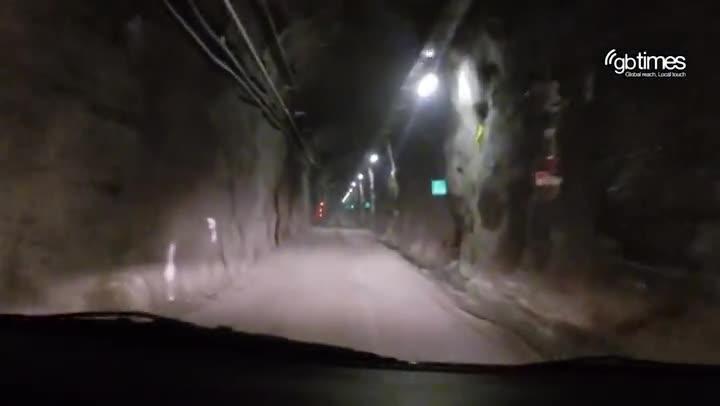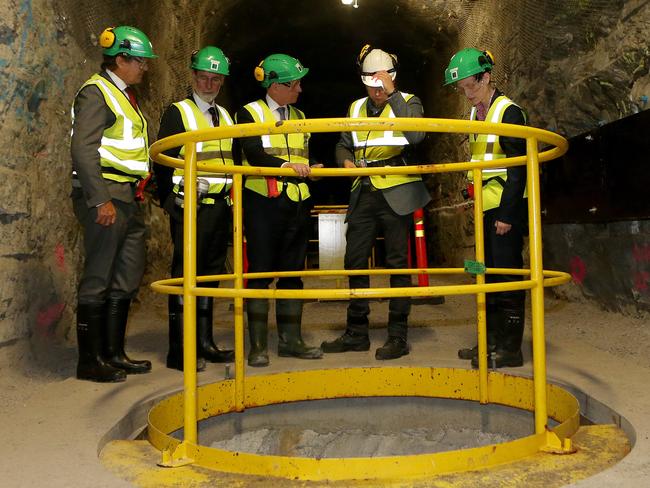Finland’s Onkalo nuclear waste disposal facility want to export the technology to South Australia
OPERATORS of the world’s most advanced nuclear disposal facility want to export the technology to South Australia and form an alliance to help the state develop its own commercial facility to take waste from around the world.

- Nuclear dossier: All your questions answered
- Jay Weatherill tours world’s most advanced nuclear waste facility
- Daniel Wills: Waste repository decision years away
- Should we spend $600m just for a nuclear waste plan?
OPERATORS of the world’s most advanced nuclear disposal facility want to export the technology to South Australia and form an alliance to help the state develop its own commercial facility to take waste from around the world.
At a briefing with Premier Jay Weatherill at Finland’s Onkalo nuclear waste disposal facility, Posiva Solutions Oy managing director Mika Pohjonen said his company would be willing to licence intellectual property and engineering solutions to SA if it were to proceed with expanding the local nuclear industry.
Mr Weatherill said the offer was a major step forward in pinning down the practical and technical aspects of a high-level nuclear waste disposal facility in SA, should the community give agreement to allow its construction and international partners seek to offload spent fuel.
Asked by The Advertiser if the technology could be licenced to Australia, Mr Pohjonen said he “would be happy to do so” and the time saved on a new build would be “significant”.
The state’s chief marketing man in Europe, Agent-General Bill Muirhead, also visited the facility and dismissed fears that hosting such a facility in SA could harm the state’s clean and green image.

Posiva is a joint venture owned by two of Finland’s biggest energy companies — Teollisuuden Voima Oyj and Fortum Power and Heat. It is set to become the first organisation in the world to bury a canister of spent nuclear fuel when they begin inserting them into the bedrock from 2020. Mr Pohjonen said SA could hope to move from site selection to burying canisters within about 15 years, less than half the time taken by Finland, because the Scandinavians had already undertaken the slow work of proving the technology.
When this process (in Finland) started in 1978, there was nothing like it in existence,” Mr Pohjonen said.
“The company expected that some of the other countries would solve this first — like the US or UK — and then we could copy and paste.
“But that didn’t go that way because they stopped for various reasons. Now we are at the point where we have progressed the furthest.
“I think that starting from scratch, from day one, the time (in Australia) would be significantly shorter than 38 years, which means the cost would also be lower.”
The Onkalo disposal site is about 10 times smaller than that conceived by SA’s Nuclear Fuel Cycle Royal Commission. However, it is the same basic design and in crystalline rock formations which are found commonly across Australia. Engineers at the company said they envisioned few problems in scaling up the design to a larger size.
Mr Pohjonen said political decisions were those most likely to delay the project in Australia and the engineering solutions were largely settled.
The company said regions of the world which were already engaged in the nuclear industry, like those near power plants, were most likely to understand and accept the science of permanent disposal. It has suggested areas near existing uranium mines in SA may be most open to operating a local waste disposal site.
Mr Weatherill said the offer of technology-sharing significantly “changes the equation” as SA considers expanding into the industry.
“They’ve been on a 38-year journey to this point,” he said. “They believe that they have learnt so many things about underground storage that can be shared with the world and they are willing to do that. This facility is dedicated to sharing information with the local community but also the international community. There is also an offer to share the technology.
“So much has been learned in Finland. The truth is that the world has to grapple with this question. What SA needs to ask itself is if it is prepared to be part of that solution.”
Mr Weatherill will by the end of the year declare a formal State Government position to Parliament on expansion of the industry.
As The Advertiser revealed on Saturday, that is most likely to be a so-called “amber light” as the state elects to “proceed with caution”.
Mr Weatherill said the next step after that would likely be meetings with potential client countries which the Royal Commission suggested could include Japan, Taiwan and Korea.
“There are lots of gates, if you like, in this process,” Mr Weatherill said after visiting Onkalo. “They all have to receive a ‘yes’ before this project can proceed.
“There will be a point where we reach an irrecoverable step where we would be seeking to make a big commitment together with international partners.
“The next major step is a threshold question about whether we maintain our prohibition against a facility for spent fuel or whether we take a step to explore it further.
“After that, there are a series of discussions that need to occur with international partners (and) series of decisions to be taken about how the authority will look to take forward a decision and obviously very substantial discussions with the Federal Government about international scientific partnerships with other places in the world such as Finland.”
Mr Muirhead, who famously capitalised on the UK horsemeat in beef scare to push high-value SA products into the market and has worked on conservative political campaigns in the UK, says other nations combine nuclear technology and premium food industries without the latter having to suffer.
Mr Muirhead is based in London and spends much of his time promoting fresh SA food and beverage. He says any threat of a negative perception over nuclear storage in SA can be overcome, and pointed to French plans to develop a facility in the famous Champagne and Brie regions as a standout example.
“Any fear I had about that has been put aside,” Mr Muirhead said. “I think the more that people understand about the whole process and cycle, the less the fear is.”
“I actually love the idea of us being pioneers and doing things first. We’ve got some really great strengths in terms of renewable energy already.”
